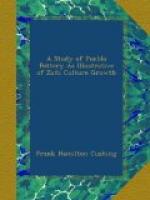Of methods, four were in vogue. The simplest and worst consisted in burying the vessel to be burned under hot ashes and building a fire around it, or inverting it over a bed of embers and encircling it with a blazing fire of brush-wood, as is still the practice of the Maricopas and other sedentary tribes of the Gila. The most common was building a little cone or dome of fuel over the articles to be baked and firing; the most perfect was to dig or construct under ground a little cist or kiln, line it evenly with fuel, leaving a central space for the green ware, and slowly fire the whole mass.
Irrespective of the kind of fuel used, the baking by ash-burial made the ware gray, cloudy, or dingy, and not very durable. Pottery burned with sage or grease-wood was firm, light gray unless of ocherous clay, less cloudy than if ash-baked, yet mottled. Turf and dung, although easily managed, did not thoroughly harden the pottery, but burned it very evenly; dead wood or spunk-cakes baked as evenly as any of the materials thus far mentioned, and more thoroughly than the others. Resinous or pitchy woods, while they produced a much higher degree of heat, could be used only when color was unimportant, as they still are used to some extent in the firing of black-ware or cooking pots. The latter, while still hot from a preliminary burning, if coated externally with the mucilaginous juice of green cactus, internally with pinon gum or pitch, and fired a second or even a third time with resinous wood-fuel, are rendered absolutely fire-proof, semi-glazed with a black gloss inside, and wonderfully durable. Tradition represents that by far the most perfect fuel was found to be cannel coal, and that, where abundant, accessible, and of an extremely bituminous quality, it was much used. The traces of little pit-kilns filled with, cinders of mineral coal about many of the ruins in the northwestern portion of the Pueblo region, coupled with the semi-fusion and well-preserved condition of most of the ancient jars found associated with them, certainly give support to this tradition. Happily I have additional confirmation. When, two years ago, I was engaged in making ethnologic collections at Moki for the United States National Museum, some Indians of the Te wa pueblo brought me a quantity of pottery. It had been made with the purpose of deceiving me, in careful imitation of ancient types, and was certainly equal to the latter in lightness and the condition of the burning. I paid these enterprising Indians as good a price as they had been accustomed to getting for genuine ancient specimens, but told them that, being a Zuni, I was almost one of themselves, hence they could not deceive me, and asked them how they had so cleverly succeeded in burning the ware. They laughingly replied that they had simply dug some bituminous coal (u a ko) and used it in little pits. When I further asked them why they did not burn their household utensils thus, they said it was too uncertain; representing that the pots did not like to be burned in the u a ko, probably because it was so hot, hence they broke more frequently than if fired in the common way with dried sheep-dung; furthermore the latter was less troublesome, requiring only to be dug from the corrals near at hand and dried to make it ready for use.




